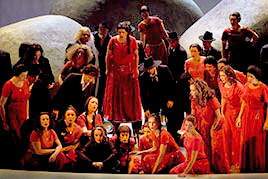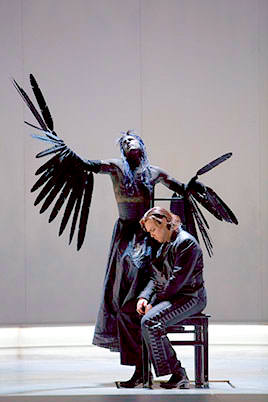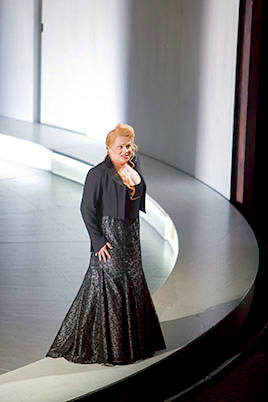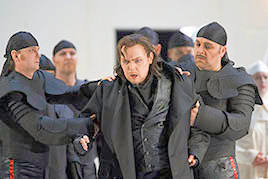Verdi, Il trovatore
at the Royal Stockholm Opera, 13.05.2006 (GF)
Conductor: Christian Badea
Direction: Wilhelm Carlsson
Set Design and Costumes: Reinhard von der Thannen
Lighting: Ellen Ruge
Cast:
Count Luna Karl-Magnus Fredriksson (baritone)
Leonora Hillevi Martinpelto (soprano)
Azucena Marianne Eklöf (mezzo-soprano)
Manrico Badri Maisuradze (tenor)
Ferrando John Erik Eleby (bass)
Inez Ingela Berglund-Kyhle (soprano)
Ruiz Carl Unander-Scharin (tenor)
An old gipsy Björn Blomqvist (bass)
A messenger Anders Blom (tenor)
The demon of revenge Mirco Andreani (miming artist)
The Royal Opera Chorus and Orchestra

The story of Verdi’s eighteenth opera has often
been castigated for being incomprehensible, illogical,
ridiculous and … add any adjective with a negative
connotation and it probably fits in, too. Director Wilhelm
Carlsson, in a short essay in the programme booklet for
the new production at the Royal Stockholm Opera, doesn’t
really deny any of this but states that “Verdi’s
deconstruction … the fragments which he picks out
of the original work are burning hot” and he goes
on to point out, as many commentators have done, that
it isn’t the large structure but the thrill of the
isolated moments that interests Verdi. “The story
about Azucena, Count Luna, his brother Manrico and Leonora
– the woman both of them love – has its labyrinths.
But the meeting between them and their passions are fully
recognizable, as clear as glass. Forget the story, meet
the human being when she hates … and loves beyond
all senses”.
This maxim is the guiding philosophy behind Carlsson’s
direction. He presents the eight scenes as eight isolated
episodes, only loosely connected and they are all played
within the same circular space, a “stage within
the stage”, like a shallow basin. At key moments
the actors can step onto the edge and deliver their arias.
Around the basin is a movable wall with doors and this
wall also functions as a second curtain. The sets are
sparse: a few large rocks in the Anvil scene, a huge green
tree being lowered during Leonora’s first aria,
and colours are mainly white and grey with some subdued
lighting, the only real exception being the Anvil scene,
where the gypsy women’s fiery red dresses reflect
the colourful music. Carlsson also trusts the impact of
the music and the acting ability of the principals and
avoids that kind of constructed side-plots being performed
in the background, which is increasingly popular among
directors today. It is a “peeled off” production
that is sometimes felt to go against the music but it
also lays bare the central conflicts. We are also reminded
that Verdi initially contemplated the title “The
revenge of the gypsy woman” and so Azucena appears
in front of the closed arena already during the short
prelude, accompanied by a miming character, the Demon
of Revenge, a big black bird that is almost omni-present
during the performance. Those in the audience who didn’t
read the synopsis in advance of course became at once
informed of the background story, recounted by Ferrando
during the first scene. I have seen some reviews feeling
this evil spirit’s presence on stage being over-explicit
but I have no objections.

Il trovatore is of course a dark, tragic story
with little redeeming light in it. Still Verdi’s
music is often cheerful, mainly in major keys and a lot
of the “rum-ti-dum” of his earlier operas.
One of the jolliest pieces in the whole opera is the soldiers’
chorus at the beginning of act III, and here it was the
opening number after the only interval. For some reason
it is staged in this production as a hilarious crayfish
party (typically Swedish! I can’t dream of medieval
Spanish soldiers indulging in such exotic pleasures) with
funny hats, some men in women’s clothes and an insane
crayfish eating competition! All right, it goes well with
the music but it jars with the rest of the drama. Maybe
Carlsson draws a parallel with Puccini who always has
some elements of comedy in his tragedies.

An unintentional comedy occurred on this opening night
when Leonora’s long dress got stuck under the closed
circular wall and her confidante Inez tried in vain to
get it loose. She had to run out in the wings to call
for help and both the audience and the two singers were
bursting with laughter before someone from the technical
staff managed to operate the wall so that Hillevi Martinpelto
finally could leave the stage. The two ladies curtsied
in the usual manner and got a round of applause.
The “clean” stage picture, as I have already
implied, allowed the music to speak even more articulately
than in a more traditional production and with Christian
Badea in the pit one could rest assured that the orchestral
contribution was on an exalted level. The standard of
the playing was consistently high and Badea’s care
over details as usual paid dividends, revealing that Verdi’s
handling of orchestral colours even in this primitive
opera is far from crude. He chose some very fast tempos
and the anvil chorus at first seemed over-rushed, but
it worked well and certainly heightened the temperature.
He also underlined the lyrical moments of the score, most
obviously in Leonora’s act IV aria, which became
one of the real highlights of the performance. This extremely
beautiful aria was drawn out to such extent that Hillevi
Martinpelto had to chop up some phrases for need of breath,
but that was more than compensated by the intensity and
feeling and all through the evening she sang with such
purity of tone, such beauty and such identification that
it is hard to imagine it better done. She is no newcomer
to Verdi: I reviewed the Stockholm Don Carlo a
year ago and she also recorded that part for Naxos almost
five years earlier, but internationally she is probably
best known as a Mozart singer, a repertoire she still
excels in. She was the Countess in Le nozze di Figaro
last autumn in Stockholm and she also sang and recorded
Vitellia in La clemenza di Tito in Edinburgh, a
recording I reviewed very favourably a few months ago.
As so often has been said, singing Mozart every now and
then preserves the lightness and agility of the voice
and since Verdi also prescribes some florid singing in
Leonora’s part, she executed them with unstinting
elegance, whereas many a spinto soprano can make quite
heavy weather of these runs. As a whole I don’t
think I have heard Hillevi Martinpelto sing better than
in this performance.
On a par with her was Karl-Magnus Fredriksson as Count
Luna. He is a terribly gifted actor and his once extremely
lyrical voice has deepened and expanded to such a degree
that today he is a fully fledged Verdian baritone, singing
with power and authority while retaining some of the lyrical
qualities. His great aria Il balen, sometimes bawled
out as a call to arms, was filled with passion and still
he never sacrifices the text by smudging the consonants.
Every syllable was clearly enunciated. A great performance.

As his twin brother Manrico, Badri Maisuradze sounded
slightly worn in the beginning but he soon regained his
usual burnished but slightly baritonal tone and delivered
full-throated heroic singing of a kind that can’t
be taken for granted anywhere today and, as I have remarked
before concerning Maisuradze, he also has a lyrical vein,
which is just as impressive as his fortes. The short love
scene with Leonoras in act III and the following Ah,
si, ben mio were masterly. Unfortunately he is not
a very convincing actor, which robbed his vocally dynamic
portrait of Manrico some of its credibility.
Marianne Eklöf delineated a sharply etched portrait
of Azucena not least through her expressive face and after
a somewhat shaky start she found a more concentrated tone
and sang throughout with great assurance. And, as my wife
pointed out, like the Devil Azucena has the best tunes!
John Erik Eleby, small of stature but an expressively
restrained actor and the possessor of a firm bass voice,
made a believable Ferrando and the smaller parts were
all well taken with an extra plus for Carl Unander Scharin,
who made much of little as Ruiz. Being also a successful
composer he contributed an interesting article on Verdi’s
music in the programme.
The last production of Il trovatore, mounted in
1972, conducted by Carlo Felice Cillario and featuring
Rolf Björling, son of Jussi, as Manrico, was a resounding
success, but it seems that Stockholm have come up with
another winner this time. It will continue to play with
the same cast during the rest of this spring, until June
17th, and it is to return in the autumn, first performance
on September 1st, with partly new singers. Don’t
miss this!
Göran Forsling
Photos: Mats Bäcker/Kungliga Operan
mats@matsbacker.se






